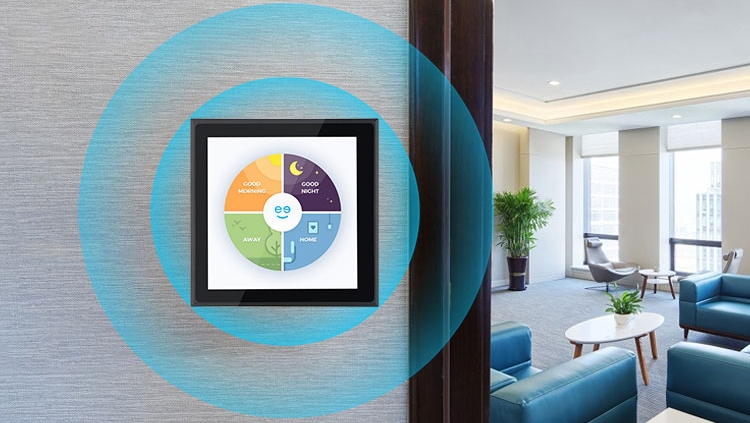What is smart home control?
With the continuous development of technology, our interaction with home environments is also evolving. The days of manually adjusting thermostats or flipping light switches are long gone. Today, smart home control systems allow homeowners to manage everything from lighting to security with just a tap on their smartphone or a voice command. But what exactly is a smart home control system, and how does it make life easier? This blog will analyze it step by step for you.
1. Introduction to Smart Home Control
A smart home control system is a technology-based solution that integrates various household devices into an interconnected network. This system allows you to monitor, control, and automate different appliances and functions in your home through a central platform, whether it’s an app on your smartphone or tablet, or voice assistants like Amazon Alexa or Google Assistant.
The essence of a smart home system lies in its ability to bring convenience, efficiency, and security to daily life. Imagine being able to control the thermostat as you drive home, or receiving an alert on your phone when someone rings your doorbell while you’re on vacation. This is the power of smart home control.
2. Components of a Smart Home Control System
The core of a smart home control system consists of several key components that work together to create a seamless experience:
Central Hub: This is the “brain” of the system that communicates with all smart devices. It can be a dedicated device, such as a Smart Things hub or Amazon Echo, or a platform like Google Home.
Smart Devices: These are the gadgets that make your home “smart.” Examples include smart lights, thermostats, door locks, cameras, and even appliances like refrigerators or ovens.
Mobile Applications or Voice Control: Users interact with the smart home system through mobile applications or voice commands. This allows you to check the status of devices, adjust settings, or create automated schedules.
Essentially, the system connects various small tools and appliances into a single network, enabling easy management through a unified interface. Whether it’s lighting, security cameras, or the blinds in your living room, everything can be synchronized and controlled centrally.
3.How Does Smart Home Control Work?
Smart home control utilizes wireless technologies like Wi-Fi, Zigbee, or Z-Wave to communicate between devices. Each smart device is equipped with sensors and communication modules that enable it to send and receive data. This data is relayed back to the central hub or a cloud-based platform, where it is processed and commands are executed.
For example, suppose you have a smart thermostat. When you adjust the temperature through a smartphone app, the request is sent over the home Wi-Fi network to the thermostat, instructing it to raise or lower the temperature accordingly.
Modern systems also rely on automation and artificial intelligence (AI). Through AI, the system learns your habits over time. For instance, it might adjust the lighting in your home based on the time of day, or automatically lower the thermostat when it knows you’re not home.

4. Benefits of Smart Home Control
Smart home control offers a variety of benefits that enhance daily life. Here are the main advantages:
Convenience: A one-stop control for everything makes managing your home effortless. Whether it’s turning off lights or adjusting the temperature, it can be done with a click or a voice command.
Energy Efficiency: One of the biggest advantages is energy savings. Smart thermostats, lighting systems, and other devices can be programmed to reduce energy consumption. You can even track usage and make adjustments based on real-time data.
Enhanced Security: Smart home systems allow you to monitor your property remotely. Smart locks, doorbell cameras, and motion sensors provide real-time alerts in case of any anomalies. You can even control who can enter your home when you’re not there.
Customization and Automation: Smart homes are not a one-size-fits-all solution. You can tailor the system to your preferences, whether it’s adjusting the thermostat before you get up in the morning or automatically dimming the lights at night.
Accessibility: For individuals with mobility challenges, smart home systems can significantly enhance accessibility. Voice commands can control lighting, doors, and even appliances, providing greater independence.
5. Popular Applications of Smart Home Control
Smart home control can be applied to nearly every aspect of a home. Here are some of the most common applications:
Lighting: Adjusting the brightness of lights or setting them to turn on and off automatically are just a few examples of how smart lighting works. You can even control the lights when you’re not home, making it look like someone is there.
Climate Control: Smart thermostats allow for precise temperature management. You can create schedules, adjust settings based on the weather, or let the system learn your temperature preferences to save energy.
Security: Smart home systems are particularly popular for home security. Cameras, smart locks, and alarm systems can be monitored remotely, and you can receive real-time alerts for any unusual activity.
Home Entertainment: From smart TVs to sound systems, you can manage your entertainment devices through a single app
6. conclusion
In short, smart home control systems are a practical solution that can improve convenience, safety, and energy efficiency. Whether you are just entering the field of smart home technology or hoping to achieve complete automation in your home, the possibilities are endless. Smart home control is shaping the future of our lives, making them easier, safer, and more enjoyable. That’s all for today’s article. If you have a feeling of excitement, hurry up and place an order to try it out. Of course, if you want to know how to use smart homes at this time, let’s continue to look forward or click on smart homes.


